The Windsor - Québec City corridor is one of the most densely-populated regions of Canada. It extends 1150 km (710 miles) along Lake Erie, Lake Ontario and the St. Lawrence Seaway extending through Southwestern, Central and Eastern Ontario and part of southwestern and Central Quebec. Much of this area is in close proximity to New York state or other U.S. border states.
Understand
[edit]Much of the region was colonized in 1784 with the influx of United Empire Loyalists fleeing the American Revolution to settle in southern Ontario; centres such as Quebec City (1608) and Montréal (1640) date back further, to the pre-1763 era of Canada as a French colony.
You will need to speak some English in most of the Ontario section of this itinerary (Cornwall is somewhat bilingual, like Ottawa, but the same is not true further into Ontario) and a bit of French if you venture outside tourist areas in Quebec (with the notable exception of "le West Island" in Montreal, a district with a sizeable anglophone minority). In areas with heavy tourist traffic (such as vieux-Québec, the old town in Quebec City) you will hear a fair amount of English due to the large number of visitors from outside the region.
A tour along the corridor is an excellent way to experience the transition between Anglophone and Francophone Canada; from monolingual English-speaking Toronto, to bilingual Ottawa and Montreal (albeit with English being dominant in Ottawa, and French being dominant in Montreal), and finally monolingual French-speaking Quebec City.
As elsewhere in Canada, the road system is metric. An 80 km/h speed limit (typical of two-lane highways in rural areas) is the equivalent of 50 mph, and fuel is sold in litres (where there are 4.546 litres in an imperial gallon or 3.785 litres in a U.S. gallon).
Prepare
[edit]If entering Canada from abroad passports are required at all crossings, including purely-local services such as the Tunnel Bus[dead link] in Windsor-Detroit or boat tours to Boldt Castle (New York) from the Canadian side.
Motorists are required to carry proof of automobile insurance; radar detectors are not permitted in either Ontario or Quebec. Travellers are advised to carry Canadian dollars; most tourist-oriented businesses accept U.S. dollars due to this region's proximity to the U.S. border but tend not to give favourable exchange rates. Fuel prices are inflated by comparison to adjacent U.S. regions due to higher taxation; it is advisable to avoid fuelling on Montreal Island or in Quebec City as prices have long been higher in these cities to encourage use of public transit.
If you intend to venture away from the main freeways and travel through every tiny town (as this itinerary suggests), a good map is essential. This page offers a general overview of what is a large and highly-populated region, despite the number of small rural towns along the way. The list of sites to see is therefore inherently an incomplete selection and cannot claim to list every point of interest in every city. It is advisable to bring city-level guides and maps for various individual places to be visited.
Get in
[edit]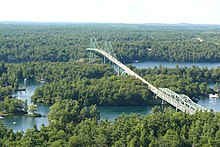
From the US, Interstate 75 (Windsor-Detroit), Interstate 81 (Thousand Islands), Interstate 87 and 89 (Montreal) all lead north to this region of Canada. Amtrak provides service to Montreal and Toronto from New York State and major airports serve both cities.
From much of Canada the Trans-Canada Highway reaches Montreal (following a similar but often not identical route further eastward). From Niagara Falls, take the Queen Elizabeth Way or travel by rail (Amtrak and Via run the Maple Leaf train from New York City to Buffalo-Niagara and Toronto). From Ottawa, take Ontario Highway 15 or 416 to reach the St. Lawrence Valley, fly to Toronto or Quebec City or travel by rail or bus to Toronto, Kingston or Montreal.
Go
[edit]
This busy corridor has long been well served by water, road, rail and air travel.
The original access to the region was via the St. Lawrence River and Great Lakes, with French settlement in the 1600s including Quebec City (1608), Trois-Rivières (1632), Montreal (1640) and Kingston (1673, as Cataraqui). While wagon trails were being constructed in the United Empire Loyalist era (1784), the first viable Montreal-Toronto road dates to 1817. The Grand Trunk railway dates to 1856 (now CN Rail, passenger service on the line is Via Rail) and the first numbered, paved highways to 1917 (the road from Windsor to Halifax was originally Highway 2 in each of Ontario, Québec, New Brunswick and Nova Scotia; much has now been renumbered, bypassed by freeway or demoted to county road status). While the first attempts at freeway construction date to 1939, the bulk of the current freeway system dates to 1952-1968.
By plane
[edit]Within the region, scheduled air flights run from Toronto Pearson (YYZ IATA) to Kingston (YGK IATA), Montréal (Dorval, YUL IATA) and Québec City (Ste-Foy, YQB IATA) as well as from Montréal to Québec.
By car
[edit]
As the corridor contains many small towns, villages and rural areas which are bypassed entirely by express bus and rail services, the only way to see everything is by motorcar.
There are two generations of main roads which cover this corridor.
Ontario Highway 401 is the busiest freeway in North America, serving the heavily congested Toronto-Montreal corridor. It continues into Québec as Autoroute 20, crossing to the south shore of the St. Lawrence River at Montréal.
Ontario Highway 2 (County Road 2 or County Highway 2 in most of Ontario, continuing as the "Chemin du Roy" or King's Highway 138 from Montréal to Québec) is a mostly two-lane main street which goes through the centre of every town and village along the way.

In design, these two roads are polar opposites. The old main street, designated as the "Heritage Highway" or "la route des pionniers" in many sections, follows wagon trails which date to 1817 or earlier. The freeway offers little to see, but at nominally 100 km/h (62 mph) is rapid; the old road is slow but visits every village along the way.
All 401/A-20 off-ramps are numbered in kilometres, from west to east. The numbers reset to zero at each provincial border. Constructed as a bypass of Ontario Highway 2, the 401 serves the following cities:
| km | City |
|---|---|
| 0 | Gordie Howe International Bridge (site preparation occurring), Windsor (Ontario) |
| 186 | London (Ontario) |
| 369 | Toronto |
| 418 | Oshawa |
| 543 | Belleville (Ontario) |
| 615 | Kingston (Ontario) |
| 696 | Brockville |
| 828 | Quebec Autoroute 20 continues 60km eastward to Montreal |
East of Montreal, Autoroute 20 follows the south shore of the St. Lawrence River to Rivière du Loup and forms part of the Trans-Canada Highway. The Trans-Canada then diverges to turn southeastward into New Brunswick and the Maritime provinces.
Quebec City is on the north shore; routes from Montréal through Trois-Rivières on the north shore are Autoroute 40 or the original king's highway, Route 138.
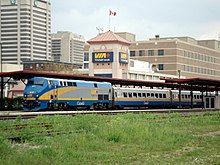
Passenger rail traffic in the corridor follows the south shore from Montreal through Drummondville (a section which parallels the Trans-Canada Highway), then crosses to the north shore at Sainte Foy to reach Quebec City. A pair of bridges across the St. Lawrence west of Québec City are the last to cross the river, although some ferry crossings exist further downstream (Quebec City to Lévis, and Saint-Siméon to Rivière du Loup).
By train
[edit]- See also: Rail travel in Canada
VIA Rail Canada, toll-free: +1-888-842-7245. Provides multiple trips daily on what it calls "The Corridor", from Windsor to Toronto, Toronto to Montreal, Toronto to Ottawa, Ottawa to Montreal and from Montreal to Quebec City. As the busiest part of the network, this corridor represents approximately two-thirds of total rail passenger traffic in Canada.
In Toronto, trains stop at Union Station downtown, near the Royal York Hotel and the CN Tower. In Montreal, the train stops at Dorval (Trudeau) Airport and in the city centre.
As this is by far the busiest (and most densely populated) train route in all of Canada, various improvements in service have been suggested to relieve the congested air and road routes. While high speed rail is under political consideration, it has been proposed several times in the past and nothing has come of it.
By boat
[edit]Cruising on small craft is possible seasonally, using the Welland Canal to travel from Lake Erie to Lake Ontario, and the St. Lawrence Seaway from Prescott to Montréal. Seaway locks at Iroquois (Ontario), Massena (New York), Beauharnois (Quebec) and Montreal accept watercraft 20 feet long and up, although priority is given to the massive "Seaway Max" freighters which fill an entire canal lock with only inches to spare.
The Thousand Islands contains several parks which are only reachable by boat.
Get around
[edit]
In major cities like Montreal or Toronto there are subways and extensive public transit; intercity bus, train and airline connections run several times daily. In small towns, a car is a necessity as local bus service is limited in small cities and non-existent in villages.
Intercity routes tend to primarily be 'express' services, where small-town stations like Napanee or Trenton may have only one train a day stop despite being on the mainline for Toronto-Ottawa and Toronto-Montreal traffic. Rural locations (such as farms or orchards where visitors are invited to pick their own apples and strawberries in season) are only accessible by motorcar.
Drive
[edit]This is an itinerary based on manufacturing a motorcar in Windsor-Detroit, the motor city, and driving the old road through every town and village. This is expressly not intended to be the fastest way to Québec City, only a path down main street that visits many small towns along the way. It is split into sections of approximately 350 km (or 200 miles) in length to allow for stops to see various places along the north shore of Lake Erie, Lake Ontario and the St. Lawrence River.
This route follows the old Highway 2 (the two-lane road used this number all the way from Windsor to Halifax through Ontario, Quebec, New Brunswick, and Nova Scotia). Almost all of this road still exists (Ontario has demoted much of it to "County Road 2" or "County Highway 2", Quebec has renumbered all of it, New Brunswick gave the old number to the newer freeway and Nova Scotia left "Highway 2" intact.)
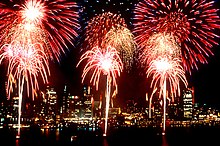
Directions are listed from west to east, starting in Windsor. This route is listed on the old two-lane Provincial Highway as it goes through every town, usually as main street. The corresponding freeway route is 401 (Windsor to Woodstock), 403 (to Hamilton), QEW (to Toronto), 401 (which becomes Québec 20, to Montréal) then Québec 40 (from Montreal to Quebec).
Windsor to Toronto
[edit]The road begins in 1 Windsor at Brighton Beach (where the planned Gordie Howe International Bridge is intended to connect to I-75 in Detroit) at the E.C. Row Expressway, then heads eastward on Regional Road 22 (through Tecumseh) and Regional Road 42 (Mill Street, Tilbury), before entering 2 Chatham-Kent as County Road 2. Like Detroit, Windsor's economy depends heavily on the automobile. The Windsor-Detroit border crossing accounts for 25% of all trade between Canada and the United States and a week-long International Freedom Festival celebrates both July 1 (Canada Day) and July 4 (US Independence Day). This region includes Point Pelee National Park, the southernmost point on the Canadian mainland and home to hundreds of migratory bird species. Sites such as the John Freeman Walls Historic Site and Uncle Tom's Cabin Historic Site recall the history of southwestern Ontario towns such as Windsor and Amherstburg as terminii on the extensive Underground Railroad that once led from slave-holding Kentucky across Ohio and the Great Lakes to freedom in Canada. American abolitionist John Brown's possessions are displayed in the Chatham-Kent Museum.

From Chatham-Kent, the old highway followed Longwoods Road into Lambeth, a 3 London suburb, then joins Highway 4 into London itself (where it heads east as Dundas Street, the city's original main street). Near London, St. Thomas is home to the Elgin County Railway Museum, Elgin County Pioneer Museum and Elgin Military Museum. London is a largely-industrial city, but was briefly the home of Sir Frederick Banting (a Banting Museum recalls his role in discovering insulin) and is host to a Royal Canadian Regiment Museum, a London Museum of Archaeology and a London Regional Children's Museum. London is home to the University of Western Ontario. To the east of the city is Fanshawe Pioneer Village, a restored village of 60 pioneer homes maintained by guides in 1800s period costume within a conservation area near the Thames River.
Dundas Street (County Road 2) continues east around 4 Ingersoll and through the centre of 5 Woodstock (whose 1853 Old Town Hall, 1854 jail and 1892 courthouse are worth a glimpse) to 6 Paris. This is agricultural country; blessed are the cheesemakers (the Ingersoll Cheese Factory Museum describes the history and the cheesemaking process). Ingersoll's Centennial Park offers a five-building museum complex; there is also a Sports Hall of Fame.
From Paris (an agricultural town whose gypsum deposits were used to manufacture plaster of Paris), the old highway turned onto Paris Road which becomes Brant Avenue in 7 Brantford. Some side trips are advised:
- 40 km (25 miles) to the north of Woodstock is 8 Stratford, home of the Stratford Festival - a huge live theatre (three stages, May-October) whose repertoire includes Shakespeare's works. The village has open parkland with swimming swans and statues recall various characters in historical film and theatre
- 45 km (28 miles) to the north of Brantford (or 16 km/10 miles northwest of 9 Cambridge and the 401 on Highway 8) is 10 Kitchener-Waterloo. Kitchener was once Berlin (the name historically appeared on a musical instrument, the Berlin Organ, but was changed during the Great War - World War 1) and is host to an annual Oktoberfest. Waterloo University is known for its engineering and computing science; the town is the birthplace of the Blackberry smart 'phone. 11 Guelph is home to Guelph University, formerly an agricultural college. The African Lion Safari park is 12 km (7 miles) southeast of Cambridge (take Highway 8 to Safari Road eastbound, then north on Cooper Road).
12 Brantford, named for Six Nations chief Joseph Brant (a Mohawk whose people colonized the region as United Empire Loyalists after fighting for the British during the American Revolution), is home to the Bell Homestead which commemorates Alexander Graham Bell's first telephone communications from Brantford to Paris.

The old highway leaves Brantford to head east on Colborne Street, which becomes Wilson Street (Brant County Hwy 2) leading past the Ancaster fairgrounds and into 13 Hamilton where it followed Wilson Street, Main Street, Paradise Rd., King Street, Dundurn Street and York Boulevard before crossing the westernmost tip of Lake Ontario. Hamilton is an industrial city known for its steelmaking; it is home to McMaster University, the Royal Botanical Gardens, the Canadian Warplane Heritage Museum and the Canadian Football Hall of Fame. It also marks the western edge of the suburban sprawl around Toronto (which continues to Oshawa in the east) and is served by Toronto commuter trains (GO Transit), intercity trains (Via Rail) and a major airport (YHM IATA).
Don't go this far without missing the most obvious sidetrip, the Niagara Region:
- 75 km (45 miles) east-southeast of Hamilton on the south shore of Lake Ontario is 14 Niagara-on-the-Lake (home of the Shaw Festival live theatre) and the Niagara Region wineries. The area includes 15 St. Catharines, 16 Niagara Falls and 17 Welland.

On continuing along the north shore of Lake Ontario into Toronto, one encounters endless suburbs (18 Burlington, 19 Oakville, 20 Clarkson and Port Credit before entering the city. The old road followed the lakeshore (Halton: Plains Road, King Road, North Shore Boulevard, Lakeshore Road, Peel Region: Southdown Road, Lakeshore Road into Toronto: Lakeshore Boulevard) and was bypassed in 1939 by the Queen Elizabeth Way, Ontario's first major freeway. The QEW is named not for Queen Elizabeth II but for her mother (also Elizabeth) who officially opened the road alongside her husband George VI (Albert Frederick Arthur George; 14 December 1895 - 6 February 1952) as part of the first royal visit to a British Commonwealth dominion. The empire was on the brink of World War II and Allied support was being urgently sought for the imminent war effort.
There are a few historic buildings in Old Oakville and access to the Lake Ontario waterfront in Port Credit.
21 Toronto is the largest city in Canada and fifth-largest in North America. Traffic will therefore be problematic if entering the city at the beginning of a workday or leaving at the workday's end; the same precautions against crime that apply in any large city must also be taken into consideration.
Toronto to Kingston
[edit]
As a large city, Toronto has many points of interest and a full list would be too lengthy to include here. A few notable landmarks include Black Creek Pioneer Village near York University, the city's downtown, theatre and shopping districts, the Canadian National Exhibition grounds and Ontario Place, major league sports venues such as the Skydome (now owned by Rogers, located next to the CN Tower (North America's tallest building) and the Toronto Zoo in the city's east end.
The old road entered at Lakeshore Boulevard in the west, then followed the downtown waterfront and turned north on Woodbine Avenue to take Kingston Road eastward (it becomes King Street in Oshawa). This was entirely bypassed by freeway (QEW, 427, 401) by 1956 and the bypass road was jammed with double its original design capacity in traffic by 1958. Highway 401 in Toronto was later widened to 12 lanes and is now the busiest road in Canada, possibly the busiest in North America.
Between Toronto and Oshawa are endless suburbs (22 Pickering, 23 Ajax, 24 Whitby) of recent vintage; as late as World War II this area was rural. Whitby was the home of Camp X, a once highly-secret training facility for British and Canadian spies during the second world war. 25 Oshawa is known primarily for its automobiles; a Canadian Automotive Museum recalls Col. Sam McLaughlin who founded a motor works which is now part of General Motors.
East of Oshawa, the countryside regains its rural character except for brief intervals when passing through towns and small cities such as 26 Port Hope, 27 Cobourg, 28 Trenton, 29 Belleville, 30 Deseronto, 31 Napanee and 32 Kingston.

In many small towns along the Lake Ontario shore, the old Highway 2 (as County Road 2, or Dundas Street in Belleville-Trenton) passes through downtown, most often as the local main street. Portions of this route are signed as an "Apple Route", an "Arts Trail" or the "Heritage Highway" (a designation which originally extended from Windsor to Québec's Gaspé Peninsula). Trenton is the home of Canada's largest air force base (there is a museum on-site) and the southern terminus of the Trent-Severn Waterway, a canal system through Peterborough.
This is United Empire Loyalist country and many individual small towns were established by Loyalists in 1784, the year after the end of the American Revolution. The road began as an 1817 wagon trail, often muddy and impassible, which served as a key mail road until the arrival of the railway in 1856. Many historic buildings (such as the Cobourg and Kingston town halls) recall an earlier era, employing elaborate architecture from an era when a city hall was also a community centre and the home of the local market or other public venues. Various reminders of the War of 1812 (or defences constructed soon after the war) remain, such as Fort York (Toronto) and Fort Henry (Kingston), the Rideau Canal and Kingston's four Martello towers.
One more side trip:
- 35 km (22 miles) south of Belleville is Picton and 33 Prince Edward County, a prime area to pick apples and strawberries in season (strawberries are often ripe just before Canada Day July 1). This area is on Lake Ontario and home to Sandbanks Provincial Park; it is also growing in popularity as a wine region, although on a much smaller scale than Niagara. The Loyalist Parkway (Ontario Highway 33, in some places County Road 33) leads along the scenic waterfront from Trenton eastward with a 15-minute ferry crossing east of Picton. It then passes through the lakefront village of Bath and ends in Kingston.
Kingston to Montreal
[edit]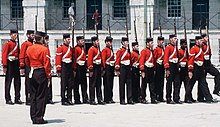

34 Kingston, founded 1673, is the home of Queen's University and the Royal Military College. It was briefly the seat of Canada's first federal legislature in 1841 (that building is now part of Kingston General Hospital) and is the home of various fortifications to guard access to the Rideau Canal and the Great Lakes, including Fort Henry, built as an 1850s defensive fortification after the War of 1812. An active military base CFB Kingston remains in operation on an adjacent site as the city's largest employer; a Military Communications and Electronics Museum is open on the base (admission by donation). Kingston hosted sailing events for the 1976 Olympics and was home to the notorious Kingston Penitentiary (which operates a Penitentiary Museum in the former warden's house). Kingston's waterfront includes a Pump House Steam Museum and Marine Museum of the Great Lakes. Bellevue House, now a national historic site, was briefly the home of local drunkard, member of parliament, first Canadian prime minister and father of Confederation Sir John Alexander MacDonald. Kingston is the starting point of the St. Lawrence River and the western edge of the Thousand Islands (there are tour boats which circle the islands, as well as car ferries to Wolfe and Howe Islands. A ferry to Amherst Island is west of the city, near Millhaven.)
Additional tour boats to the 1000 Islands run from 35 Gananoque, Rockport and 36 Brockville; a handful still stop at Boldt Castle on the U.S. side, although tightened passport restrictions in the wake of the September 11, 2001 attacks have made any side trips involving New York State more difficult. Gananoque is home to the 1000 Islands Playhouse (which operates seasonally from a former canoe club and firehall) and a casino. It is possible to rent bicycles and tour the 1000 Islands Parkway, a scenic route which bypasses Highways 2 and 401 by following the waterfront almost to Brockville]. In the centre of the 1000 Islands International Bridge the 1000 Islands Skydeck stands tall above Hill Island, Ontario. Brockville's waterfront, one block south of the historic town hall Victoria Hall, contains parkland and marina facilities; the southern end of an 1800s railway tunnel is viewable in the park.

37 Prescott is the home of Fort Wellington, which like Fort Henry and Fort York was constructed in the 1800s to defend the Canada-US border. The St. Lawrence Seaway and canal locks for huge ships extend eastward toward Cornwall and Montréal; some towns upstream of Cornwall-Massena were flooded by seaway construction in 1958 - these Seaway Lost Villages no longer exist. Historic buildings in the area were relocated to establish Upper Canada Village in 38 Morrisburg, a historic village interpreted by guides in period costumes from an era of small boat canals and horse-drawn carriages.
One worthwhile side trip would be to head north to the Rideau Canal, which leads from Kingston to Ottawa:
- 75 km (45 miles) north of Prescott-Ogdensburg is Ottawa-Hull, the tulip capital of Canada as Stornaway in Ottawa was home of the Netherlands government-in-exile during World War II; Holland has donated tulips for an annual Tulip Festival as a gesture of thanks. Ottawa has a large selection of museums and easy access to the Trans-Canada Highway so that travellers may continue onward to Montréal directly. Between Kingston and Ottawa are various small towns such as 39 Smiths Falls (the canal's midpoint, and home to a railway museum) and 40 Merrickville (a tiny village on the canal with many old buildings and charming, small shops and restaurants). One may detour at Kingston (Highway 15) or Brockville (former Highway 29) to reach Smith's Falls (these are two-lane roads) or reach 41 Ottawa from Prescott (416, a freeway that runs from Highway 401 to Highway 417 in the western end of Ottawa) or Morrisburg (former Highway 31 which becomes Bank Street in Ottawa and runs through the middle of the city) - it will take about an hour to reach downtown Ottawa on either route.

If you stay on Highway 2 (County Road 2) instead of taking the Ottawa side trip, parkland on a series of islands at Long Sault (just west of 42 Cornwall) provides an excellent view of the St. Lawrence River. East of Cornwall, the road soon crosses into the province of Québec. Ontario Highway 2 becomes Québec 338 and Ontario 401 becomes Québec autoroute 20. It is advisable to refuel as Quebec's fuel taxes increase significantly soon after the border, with an even steeper jump when on Montreal Island. Fuel costs a dime a litre more, largely as a provincial incentive for les montréalais to take the Métro, Montreal's subway system.
The two roads continue eastward to Dorion (a suburb west of Montreal) before converging into one road to cross Île-Perrot into Montréal. This section is a four-lane surface highway with traffic lights and commercial businesses; portions have been converted to freeway.
Once on Montreal Island, the roads diverge with the old road becoming Québec highway 138, the "chemin du roi" or king's highway which follows the north shore of the St. Lawrence to Quebec City via Trois-Rivières. Autoroute 20 crosses to the south shore after Montréal, where it forms part of the Trans-Canada Highway.
Montreal to Quebec
[edit]- This route follows the north shore; for the south shore itinerary see Trans-Canada Highway.
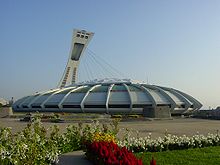
43 Montréal is the second-largest Canadian city (behind Toronto) and has hosted major events such as Expo 67 and the 1976 Summer Olympics. Facilities built for these huge and costly events include La Ronde (an amusement park on what was the Expo site), le Stade Olympique (the home of the Expos baseball club before they left the city) and le Biodôme (a biological museum in what used to be the vélodôme - an Olympic cycling venue). Montreal is home to Québec's only major league hockey team, the Montréal Canadiens ("les habitants").

Founded in 1640, Montreal is the third-oldest city in the region (behind Trois-Rivières 1632 and Quebec City 1608) and therefore has an extensive and well-maintained Old Town district known as vieux Montréal in which visitors can be seen touring in calèches (horses and carriages). The calèche tour itself is expensive (typically $50 or more) but the area is well suited to a self-guided tour on foot. Bring a camera to get plenty of photos (une image vaut 1000 mots, même en français) of the old town, the horses and the calèche.

East of Montreal, the Chemin du Roy or king's highway (Québec 138) leads east along the north shore of the river through Trois-Rivières. 44 Joliette's 2000-seat outdoor amphitheatre hosts the summer Festival international de Lanaudière with a wide variety of live music; the local Musée d'Art houses a museum collection of over 5000 pieces. 45 Berthierville is home to the Musée Gilles Villeneuve, a museum dedicated to the career of the former racecar champion.
A side trip to the north (Mauricie):
- 80 km (50 miles) north of Trois-Rivières on the St. Maurice River is la Mauricie National Park, a wilderness area in Québec's Laurentian Mountains. Other, shorter sidetrips north from Trois-Rivières include Shawinigan (home of former prime minister Jean Chrétien), established as a hydroelectric generation centre in 1899; there is a 100-m (325-foot) observation tower to view Shawinigan Falls and an interpretive centre describes early industrialisation of the region. Les Forges du Saint Maurice, a national historic site 13 km (8 miles) north of Trois-Rivières, displays working rebuilt and reconstructed historic forge and ironworking industries of the 18th and 19th centuries.

46 Trois-Rivières, originally a 1634 fur trading post, is now primarily an industrial centre although cruises of the St. Lawrence and St. Maurice rivers are offered (May-Sept) from Parc Portuaire on the downtown waterfront. While a significant portion of old Trois-Rivières was lost to a 1908 fire, some historic buildings still remain on rue des Urselines in the city centre including a convent and monastery, as well as historic manors which now house an art gallery, antiques and museums. Museums in the city cover everything from military history to missionaries to the fur trade to arts and crafts; there's also an 1822 jail whose 20 cells depict 19th-century prison life.
East of Trois-Rivières is 47 Cap-de-la-Madeline, home of a 2000-seat shrine to the Virgin Mary. 48 Ste-Anne-de-la-Pérade is a popular ice fishing spot on the St. Anne River which hosts a winter carnival. Cap Rouge is marked as the site of Jacques Cartier's ill-fated 1541 attempt to establish the first French settlement in Canada; this was abandoned after an initial harsh winter and nothing remains. 49 L'Ancienne-Lorette was the site of a 1673 Jesuit mission to the Hurons; the current church at this location dates to the early 1900s.
There are many stone buildings on this old highway; farms along the riverfront in this region were by design long and narrow so that each would have some tiny amount of access to the river. One distinctively-québécois form of eatery in the region is the casse-crôute (literally: "break the crust"), roadside snack vendors who serve Québec dishes such as poutine (French fries with cheese curds and gravy).
It is advisable to refuel before entering the Québec City area as the province charges substantially higher fuel taxes in the city.
Quebec City-Lévis
[edit]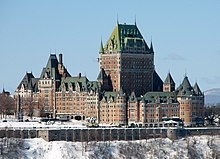
In the western suburbs of Quebec City is Ste. Foy, a suburb which is home to Laval University and is the last point at which the St. Lawrence River is narrow enough to be easily bridged. (The city's name, Québec, is taken from the Algonquin word "kebec," which means "where the river narrows".)
There are two bridges at Ste. Foy. The 1918 Pont de Québec is a steel cantilever road and rail bridge which was one of the longest of its kind in Canada; two previous attempts at this engineering feat (in 1907 and 1916) ended tragically when collapses of bridges under construction killed hundreds of workers. Cross-country traffic on the former Quebec 2 highway took the Chemin du Roi (now Quebec 138) from Montreal to Ste. Foy, crossed the Pont de Québec, then followed a routing similar to the Trans-Canada Highway (on what is now Québec 132 and 185) to Highway 2 in New Brunswick and Nova Scotia. Rail traffic from Quebec City to Halifax crosses here, as this is the last chance to bridge the St. Lawrence. The modern Pierre Laporte suspension bridge, named for a Québec cabinet minister assassinated during the October Crisis by terrorists advocating the secession of Quebec from Canada, opened in 1970 as a freeway bypass.

50 Quebec City is a European-style walled city constructed on a cliff to make attack more difficult. British forces under General Wolfe attacked upriver in 1759 at the Plains of Abraham, a now-historic battlefield outside the walls defended by Général Montcalm for the French. Neither leader survived the battle; both are commemorated on opposite sides of the same monument. A later British fortress on the site is the Citadelle de Québec, defended by the modern-day vingt-deuxième régiment (22nd, or "van-doos", based in Québec and Valcartier) of the Canadian Army, which is known for the irony of being exclusively French-speaking despite the fact that their ceremonial uniforms are clearly British in origin. Québec's legislative assembly is also just outside the historic walls of the old city, on a major street known as the Grande Allée.
The walled city, because it is constructed on a cliff face, is split into two parts, an old Lower Town (Basse-Ville) which houses shops and expensive French restaurants and an Upper Town (Haute-Ville) around the landmark Château Frontenac railway hotel. Quebec City is famous for its many old buildings, steep but narrow streets and for its popular Winter Carnival.
Opposite Quebec City on the St. Lawrence is Lévis, a former shipbuilding centre.
Stay safe
[edit]In rural areas there is some risk of collision with deer on the highways, particularly on two-lane roads. In large cities, similar precautions apply as for comparably-sized settlements in other western nations.
Crime does occur, albeit at rates less than that of the US and comparable to Europe. Provincial police may be reached by mobile telephone by dialling *OPP in Ontario or *4141 in Québec; cellular coverage is extensive by Canadian standards with few gaps as the corridor is one of the busiest, most heavily-travelled and most populous regions.
Travellers from other Canadian provinces will typically have full or partial coverage from their home province's health plan; the same may not be true for international visitors. Health care is inexpensive by U.S. standards but wait times are often longer.
Connect
[edit]Cellular phone service is excellent along the Windsor-Quebec corridor. In the rural areas, you may encounter spotty cellular service or slow data speed.

